Accepting payments in Central & Eastern European markets: guide


E-commerce continues to take shape in Central and Eastern Europe, opening up many opportunities for business expansion. So, before you solemnly enter these countries with your product, studying the basic payment norms and specificities of the Central & Eastern European markets is essential. We’ll help you with this.
Let’s take a closer look at the general trends in Central & Eastern European e-commerce and the payment methods local buyers prefer.
Countries in Central and Eastern Europe differ greatly in politics, culture, and economy, affecting people's lifestyles and how they prefer to make payments. Despite the changing economic and political conditions, e-commerce is still rising.
The top 5 countries with the highest annual e-commerce growth rate in CEE by 2022 are:
Compared to Western Europe, which holds 67% of the total B2C turnover for 2022, Central Europe (8%) and Eastern Europe (2%) have a considerably lower share. Such a difference can be attributed to various factors. Western Europe generally has more established and mature e-commerce markets, with higher levels of internet penetration, digital literacy, and consumer trust in online transactions. However, the significant growth rates in e-commerce observed in certain countries within CEE suggest a potential for expansion and development in the coming years.
Many countries in Central and Eastern Europe boast a digitally savvy population, driving a substantial demand for both online shopping and digital payment methods.
As of 2022, internet penetration rates in Central and Eastern Europe have soared to an impressive 91% and 88%, respectively. Furthermore, online shoppers have grown significantly, rising from 69% in 2019 to 77% in 2022 in Central Europe and from 32% in 2019 to 48% in 2022 in Eastern Europe. This upward trend underscores the region's increasing embrace of digital technologies for commerce and transactions.
What shapes payment preferences among CEE consumers? First of all, the rapid development of e-commerce and online shopping required new, non-cash payment methods. While credit and debit cards are popular, the younger generation and active smartphone users are shifting towards digital and mobile wallets, responding to the demand for newer, non-cash payment methods.
In 2022, Ukraine led in adopting e-wallets as a preferred payment method, standing at 35%. Hungary follows closely behind with a usage rate of 30%, while Romania holds the third position with 23%.
Nevertheless, cards maintain their prevalence as a preferred payment method in certain CEE countries. Slovakia takes the lead with the highest card usage rate at 48%, while Czechia and Hungary closely follow suit with similar rates of 36%.
Bulgaria retains its status as the 'cashiest' country, with a significant 67% of consumers preferring to pay with cash.
Here is the list of the most popular payment methods in Central & Eastern European countries:
The Central & Eastern European e-commerce scene is diverse and a bit tricky to navigate. If you're considering getting into this market, weigh the pros and cons carefully.
Meeting consumers' fast-changing needs is key to successful sales in this region. You need to provide your Central and Eastern European audience with preferred payment methods. Creating a positive customer experience with multiple payment options will build trust in your brand and help you quickly gain a foothold, even in a competitive market.
If you're ready to expand your business globally and target consumers in Central & Eastern Europe, it's essential to broaden your payment options. Do it with Corefy — a universal feature-rich payment hub that helps businesses set up and manage multiple payment methods at once.